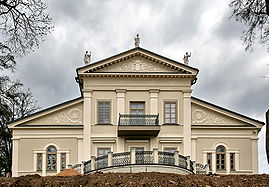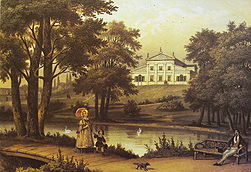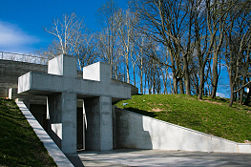
Tuskulenai Manor
Encyclopedia

Neoclassical architecture
Neoclassical architecture was an architectural style produced by the neoclassical movement that began in the mid-18th century, manifested both in its details as a reaction against the Rococo style of naturalistic ornament, and in its architectural formulas as an outgrowth of some classicizing...
manor
Manor house
A manor house is a country house that historically formed the administrative centre of a manor, the lowest unit of territorial organisation in the feudal system in Europe. The term is applied to country houses that belonged to the gentry and other grand stately homes...
in Žirmūnai elderate of Vilnius
Vilnius
Vilnius is the capital of Lithuania, and its largest city, with a population of 560,190 as of 2010. It is the seat of the Vilnius city municipality and of the Vilnius district municipality. It is also the capital of Vilnius County...
, Lithuania
Lithuania
Lithuania , officially the Republic of Lithuania is a country in Northern Europe, the biggest of the three Baltic states. It is situated along the southeastern shore of the Baltic Sea, whereby to the west lie Sweden and Denmark...
.
Structures

Karol Podczaszynski
Karol Podczaszyński was a Polish-Lithuanian architect, a representative of the neoclassical architecture and a professor of the Imperial University of Vilna, as well as one of the pioneers of industrial design....
in the neoclassical style
Neoclassical architecture
Neoclassical architecture was an architectural style produced by the neoclassical movement that began in the mid-18th century, manifested both in its details as a reaction against the Rococo style of naturalistic ornament, and in its architectural formulas as an outgrowth of some classicizing...
, by the order of the Governor General of Lithuania, Alexander Rimsky-Korsakov
Alexander Korsakov
Alexander Mikhailovich Rimsky-Korsakov was a Russian General remembered as an unlucky assistant to Alexander Suvorov during his Swiss expedition of 1799–1800....
. It consists of the principal building - the palace, a storage house, and several adjacent buildings, including a small eclectic
Eclecticism
Eclecticism is a conceptual approach that does not hold rigidly to a single paradigm or set of assumptions, but instead draws upon multiple theories, styles, or ideas to gain complementary insights into a subject, or applies different theories in particular cases.It can sometimes seem inelegant or...
chapel of St. Theresa, located approximately 100 metres south of the principal building.
The palace is the main architectural accent of the ensemble, showing clear influence of Palladian
Palladian architecture
Palladian architecture is a European style of architecture derived from the designs of the Venetian architect Andrea Palladio . The term "Palladian" normally refers to buildings in a style inspired by Palladio's own work; that which is recognised as Palladian architecture today is an evolution of...
layout. Typical Podczaszyński's serlianas - three interconnected windows - have been employed in the façades of the main palace. Three statues of Roman goddesses Diana
Diana (mythology)
In Roman mythology, Diana was the goddess of the hunt and moon and birthing, being associated with wild animals and woodland, and having the power to talk to and control animals. She was equated with the Greek goddess Artemis, though she had an independent origin in Italy...
, Juno
Juno (mythology)
Juno is an ancient Roman goddess, the protector and special counselor of the state. She is a daughter of Saturn and sister of the chief god Jupiter and the mother of Mars and Vulcan. Juno also looked after the women of Rome. Her Greek equivalent is Hera...
and Venus
Venus (mythology)
Venus is a Roman goddess principally associated with love, beauty, sex,sexual seduction and fertility, who played a key role in many Roman religious festivals and myths...
used to stand on a front one, were removed later on and restored in 2007. Their reconstruction was in part based on works of French
French people
The French are a nation that share a common French culture and speak the French language as a mother tongue. Historically, the French population are descended from peoples of Celtic, Latin and Germanic origin, and are today a mixture of several ethnic groups...
sculptor Jean-Nicolas-Louis Durand
Jean-Nicolas-Louis Durand
Jean-Nicolas-Louis Durand was a French author, teacher and architect. He was an important figure in Neoclassicism, and his system of design using simple modular elements anticipated modern industrialized building components...
. The side entrances with balconies had also been destroyed back in the late 19th century and restored. The interior was decorated with the works of Dutch
Netherlands
The Netherlands is a constituent country of the Kingdom of the Netherlands, located mainly in North-West Europe and with several islands in the Caribbean. Mainland Netherlands borders the North Sea to the north and west, Belgium to the south, and Germany to the east, and shares maritime borders...
painters Isaac van Ostade
Isaac van Ostade
Isaac van Ostade was a Dutch genre and landscape painter.-Biography:Van Ostade began his studies under his brother, Adriaen, with whom he remained till 1641, when he started his own practice...
, Adriaen van Ostade
Adriaen van Ostade
Adriaen van Ostade was a Dutch Golden Age painter of genre works.-Life:...
, Gerard Dou
Gerard Dou
Gerrit Dou , also known as Gerard and Douw or Dow, was a Dutch Golden Age painter, whose small, highly-polished paintings are typical of the Leiden fijnschilders...
and others. Numerous frescoes have been discovered in the interior of the main palace and restored by 2009. The palace also boasted a rich library. The buildings were surrounded by a large park.
All of these structures are currently undergoing restoration
Building restoration
Building restoration describes a particular treatment approach and philosophy within the field of architectural conservation. According the U.S...
, and will be part of the Peace Park (Rimties parkas), which is scheduled for completion in 2008. The 7.5-hectare park will include the restored Tuskulėnai Manor, which will host a museum of martyrology
Martyrology
A martyrology is a catalogue or list of martyrs , arranged in the calendar order of their anniversaries or feasts. Local martyrologies record exclusively the custom of a particular Church. Local lists were enriched by names borrowed from neighbouring churches...
in Lithuania in the second half of the 20th century (a branch of the Lithuanian Museum of Genocide Victims
Museum of Genocide Victims
The Museum of Genocide Victims in Vilnius, Lithuania was established in 1992 by order of the Lithuanian Ministry of Culture and the President of the Lithuanian Union of Political Prisoners and Deportees. In 1997 it was transferred to the Genocide and Resistance Research Centre of Lithuania...
), restored ponds and park vegetation, as well as the columbarium.
Polish-Lithuanian Commonwealth

St. Peter and St. Paul's Church, Vilnius
St. Peter and St. Paul's Church in Vilnius is a Roman Catholic church located in the Antakalnis neighbourhood of the city. Its interior has masterful compositions of stucco mouldings by Giovanni Pietro Perti and ornamentation by Giovanni Maria Galli of Milan, and is considered a Lithuanian Baroque...
in Antakalnis
Antakalnis
Antakalnis is an eldership in the Vilnius city municipality, Lithuania. Antakalnis is one of the oldest historical suburbs of Vilnius City. It is located in the eastern section of Vilnius, along the right bank of the Neris River...
, the Royal Manor, so called Derevnictva (Polish: Derewnictwo), was established in the middle 16th century by the King Sigismund Augustus in order to supply vegetables and meat to Vilnius Castles. The manor was held by the kings Sigismund III Vasa
Sigismund III Vasa
Sigismund III Vasa was King of Poland and Grand Duke of Lithuania, a monarch of the united Polish–Lithuanian Commonwealth from 1587 to 1632, and King of Sweden from 1592 until he was deposed in 1599...
and Władysław IV Vasa
Władysław IV Vasa
Władysław IV Vasa was a Polish and Swedish prince from the House of Vasa. He reigned as King of the Polish–Lithuanian Commonwealth from 8 November 1632 to his death in 1648....
, nobleman M. Piegłowski, the Wołowicz family, Grand Hetman of Lithuania Michał Kazimierz Pac, as well as the Tyzenhaus family
Tyzenhaus
Tyzenhaus was a noble family of the Polish–Lithuanian Commonwealth of German extraction. It was active in the Duchy of Livonia, Duchy of Courland and the northern Grand Duchy of Lithuania...
(since 1741). The manor was named Tusculanum after a resort area near Rome
Rome
Rome is the capital of Italy and the country's largest and most populated city and comune, with over 2.7 million residents in . The city is located in the central-western portion of the Italian Peninsula, on the Tiber River within the Lazio region of Italy.Rome's history spans two and a half...
http://www.villatuscolana.it/fsistemauk.htm in the place of the ancient Roman city of Tusculum
Tusculum
Tusculum is a ruined Roman city in the Alban Hills, in the Latium region of Italy.-Location:Tusculum is one of the largest Roman cities in Alban Hills. The ruins of Tusculum are located on Tuscolo hill—more specifically on the northern edge of the outer crater ring of the Alban volcano...
by Lateran
Basilica of St. John Lateran
The Papal Archbasilica of St. John Lateran , commonly known as St. John Lateran's Archbasilica and St. John Lateran's Basilica, is the cathedral of the Diocese of Rome and the official ecclesiastical seat of the Bishop of Rome, who is the Pope...
monks, who owned the central part of the manor in the middle 18th century after it was partitioned into the folwark
Folwark
Folwark is a Polish word for a primarily serfdom-based farm and agricultural enterprise , often very large. Folwarks were operated in the Crown of Poland from the 14th century and in the Grand Duchy of Lithuania since the 15th century, from the second half of the 16th century in the joint...
s of Tuskulėnai (or Tuskulionys), based on the kernel of the old royal manor, and Derevnictva.
Russian Empire
Under the rule of the Russian EmpireRussian Empire
The Russian Empire was a state that existed from 1721 until the Russian Revolution of 1917. It was the successor to the Tsardom of Russia and the predecessor of the Soviet Union...
in the 19th century, Tuskulėnai Manor was held by various noble families and high-ranking state officials. In the mid-19th century the main palace was transformed into a guesthouse by prominent doctor and public activist Julian Titius that became a cultural center in Vilnius, often visited by Stanislaw Moniuszko
Stanislaw Moniuszko
Stanisław Moniuszko was a Polish composer, conductor and teacher. His output includes many songs and operas, and his musical style is filled with patriotic folk themes of the peoples of the former Polish-Lithuanian Commonwealth...
and Józef Ignacy Kraszewski
Józef Ignacy Kraszewski
Józef Ignacy Kraszewski was a Polish writer, historian and journalist who produced more than 200 novels and 150 novellas, short stories, and art reviews He is best known for his epic series on the history of Poland, comprising twenty-nine novels in seventy-nine parts.As a novelist writing about...
. The manor passed into the possession of Julija Safranovich after 1886, and then was held by the noble family of Melentjevy until World War II
World War II
World War II, or the Second World War , was a global conflict lasting from 1939 to 1945, involving most of the world's nations—including all of the great powers—eventually forming two opposing military alliances: the Allies and the Axis...
.
Soviet rule

KGB
The KGB was the commonly used acronym for the . It was the national security agency of the Soviet Union from 1954 until 1991, and was the premier internal security, intelligence, and secret police organization during that time.The State Security Agency of the Republic of Belarus currently uses the...
officers' apartments and as a kindergarten. During excavations that took place between 1994 and 1996 in its territory, the remains of 706 bodies were found; 40 were identified. The area had been used to hide the bodies of Lithuanian residents - mostly resistance fighters against the Soviet occupation
Forest Brothers
The Forest Brothers were Estonian, Latvian, and Lithuanian partisans who waged a guerrilla war against Soviet rule during the Soviet invasion and occupation of the three Baltic states during, and after, World War II...
, Nazi collaborators and Armia Krajowa
Armia Krajowa
The Armia Krajowa , or Home Army, was the dominant Polish resistance movement in World War II German-occupied Poland. It was formed in February 1942 from the Związek Walki Zbrojnej . Over the next two years, it absorbed most other Polish underground forces...
soldiers - who had been executed between 1944 and 1947 by the NKGB and MGB
Ministry for State Security (USSR)
The Ministry of State Security was the name of Soviet secret police from 1946 to 1953.-Origins of the MGB:The MGB was just one of many incarnations of the Soviet State Security apparatus. Since the revolution, the Bolsheviks relied on a strong political police or security force to support and...
in the Vilnius' KGB Palace prison near Lukiškės Square
Lukiškes Square
Lukiškės Square is the largest square in Vilnius, Lithuania, located in the center of the city. A major street in Vilnius, Gediminas Avenue, passes by the southern border of the square...
(now Museum of Genocide Victims
Museum of Genocide Victims
The Museum of Genocide Victims in Vilnius, Lithuania was established in 1992 by order of the Lithuanian Ministry of Culture and the President of the Lithuanian Union of Political Prisoners and Deportees. In 1997 it was transferred to the Genocide and Resistance Research Centre of Lithuania...
). The remains from the mass grave
Mass grave
A mass grave is a grave containing multiple number of human corpses, which may or may not be identified prior to burial. There is no strict definition of the minimum number of bodies required to constitute a mass grave, although the United Nations defines a mass grave as a burial site which...
were placed in a columbarium
Columbarium
A columbarium is a place for the respectful and usually public storage of cinerary urns . The term comes from the Latin columba and originally referred to compartmentalized housing for doves and pigeons .The Columbarium of Pomponius Hylas is a particularly fine ancient Roman example, rich in...
built underground, beneath an artificial hill, and consecrated in 2004.
The area surrounding the Tuskulėnai Manor was referred to as Tuskulionys until World War II. This area was also known by the colloquial placename Losiovka, named after A. Losev, colonel of Special Corps of Gendarmes
Special Corps of Gendarmes
The Special Corps of Gendarmes was the uniformed security police of the Russian Empire in the 19th and early 20th centuries. Its main responsibilities were law enforcement and state security....
and later general of the Russian Empire, who owned the folwark of Tuskulėnai in 1869.

